Note: This is a compilation of Frontier Friday, a weekly Substack published, originally released on 14 Apr. 2023
PART I
- 📽Watch: Nancy Duarte
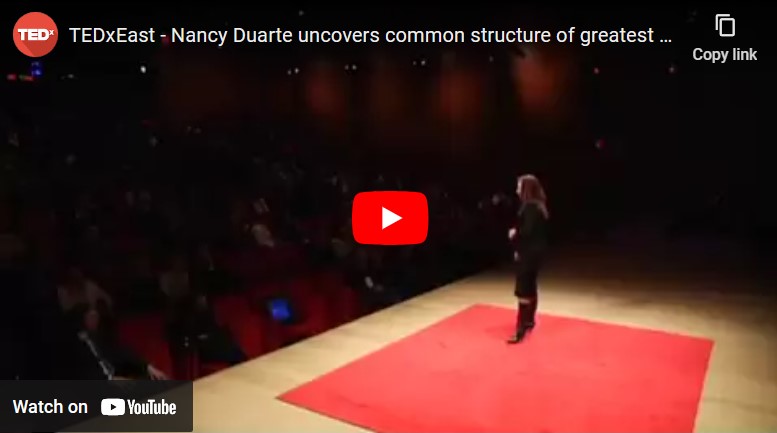
Even though I first came across Nancy Duarte’s work because of my interest in improving the way I teach, I’ve found that much of her ideas cross-pollinated into the way I think about how I structure the therapy hour.
Her book, Resonate is a good resource to have as well.
(At the risk of offending your boss, if they are prone to go powerpoint-crazy, her older book, Slide:ology might be a good present!) - 📕Read: Forms of Vitality
Daniel Stern was a well-known psychoanalyst from his landmark writings on mother-infant attachment.
A less well-known book that he wrote, called Forms of Vitality, gave words to ideas I’ve felt for a long while, stemming from my history with music.
In this book, Stern illustrates how an understanding of vitality can help the psychotherapeutic process.
While this book isn’t about how to “structure” your work, to me the relationship of structure and emotional impact are interwoven.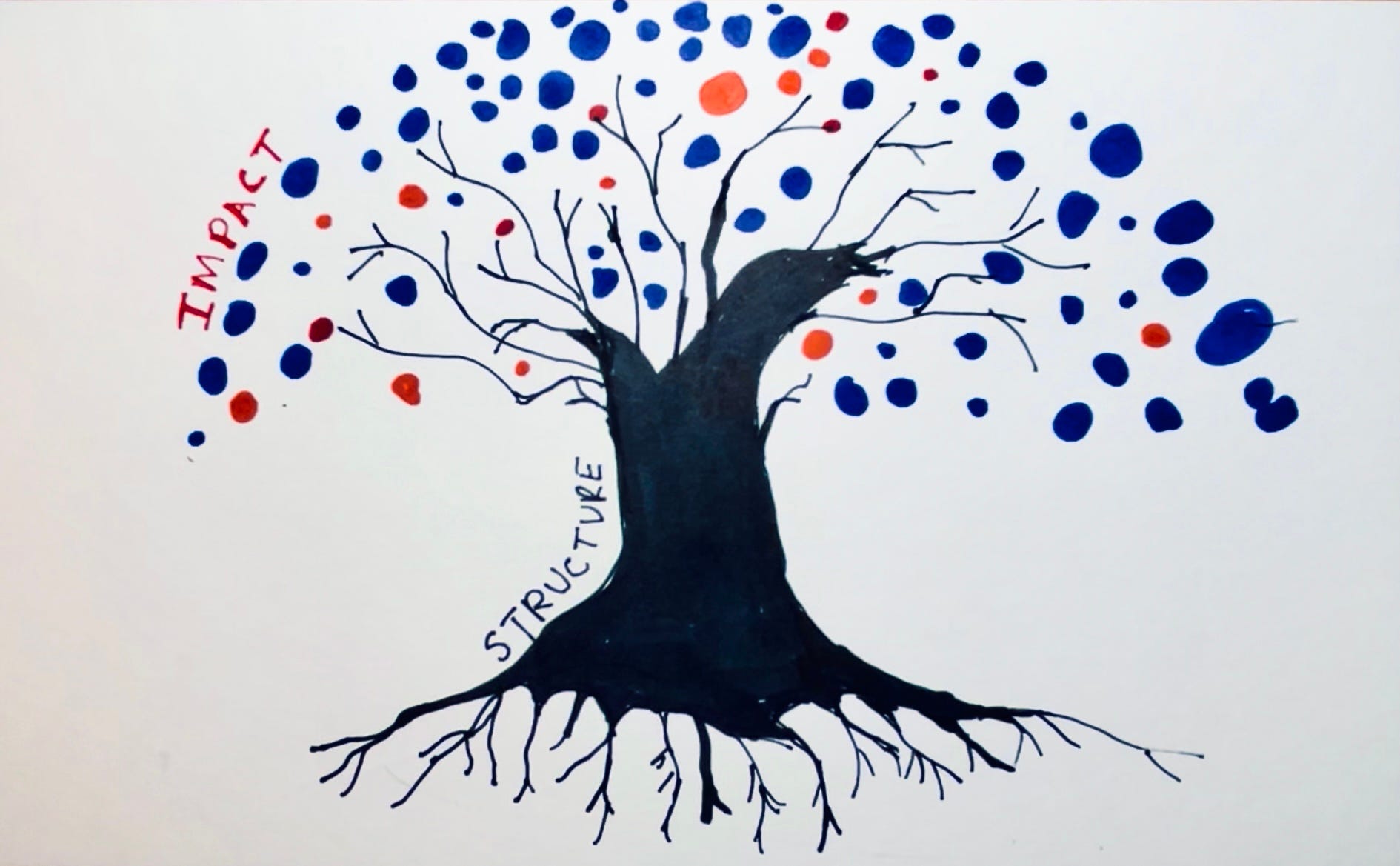
Relationship of structure and impact. - 📈 Read: The Story Grid
I had never come across anything quite like this.
I came across Shawn Coyne’s work because of his editing work with renowned author Steven Pressfield (author of The War of Art).
Reading this book was like someone pulling back the curtains and revealing trade secrets to the craft of writing.
Story Grid gave inspiration to how I would think not only about how I structure sessions, but also helped me create the Session Impact Grid (ISG), which is a way to “X-ray” a session recording. I use the ISG whenever I review therapy session recordings, be it from my own, others I supervise, or even watching master therapists at work.
I’ve talked about the ISG in Section III of The First Kiss, and I go in-depth with this in the Structure and Impact course. Here’s an example based on a therapy session. - ⭕️ Archives From My Desk: Thinking in Thirds
Part I: The Rule of Three
Part II: Going Deeper
Part III: Closing the Session
Here’s an archive based on a 3-part series that I wrote about how we can use thinking in thirds to help you construct your sessions. - ⏸ Words Worth Contemplating:
“The higher your structure is to be, the deeper must be its foundation.”
~ St Augustine.
Reflection:
In the sea of our daily-weekly busy madness, what is something that you lean on in your life right now?
PART II
- 🔖 Web-Read: Audiences Grow Weary of Stories That Never End
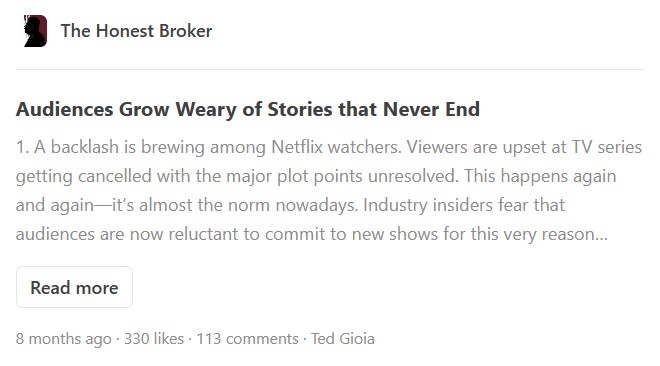
I’m a huge fan of Ted Gioia’s body of work on music and culture (e.g., Music: A Subversive History). He’s here on Substack too, called the Honest Broker.
Gioia’s highlights the issue about stories that collapse without closure, “the narrative arc reduced to “one damn thing after another.”
“Hollywood is so obsessed with sequels, prequels, reboots, and spinoffs that they can’t afford to let any good story come to an end.”
This is one of the reasons I tell my wife that I will not watch a Netflix television series, unless I know that that there’s an ending.
I’m sharing this post because we have to think about not just how we close sessions, but also how we plan for closures in therapy.
I know therapists tend to think in terms of moving clients into “maintenance phase.” Several people in my caseload are nowhere near what we call “brief” therapy. Even then, we have to think about what it means to close a particular chapter in their journey.
Delineating closure of a particular phase in client’s lives helps to add a sense of order in the sea of chaos that often goes hand-in-hand with the healing endeavor. - 📽 Watch: The Rule of 3
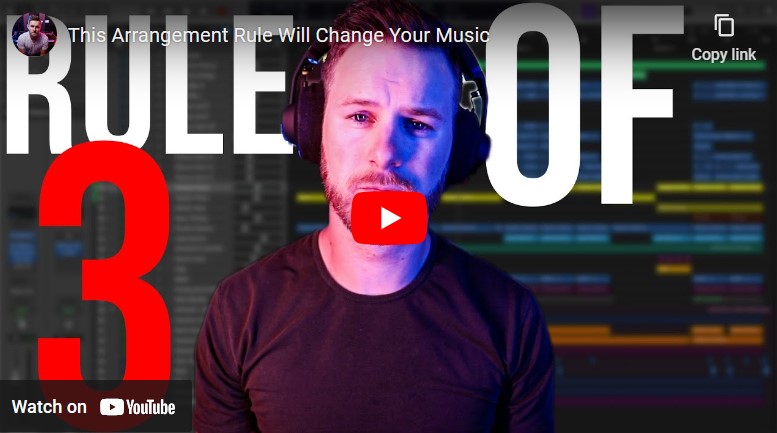
Take a moment and step outside the Psychotherapy-land, and watch this video on music composition.
Music is the perfect example of how one creates expectations and then subverts them. This is why music that pushes too far the boundaries of our expectations might sound “too unpalatable,” (think experimental jazz) and music that plays to a formula might sound cliche (think pop jingles).
After watching this video, think about how this applies to your work in the clinical hour.
Key Grafs:
– The amount of times you should repeat the idea without over repetition.
– Too much of a good thing is no longer a good thing. - 📽 Watch: Why Every Johnny Harris Videos Goes Viral
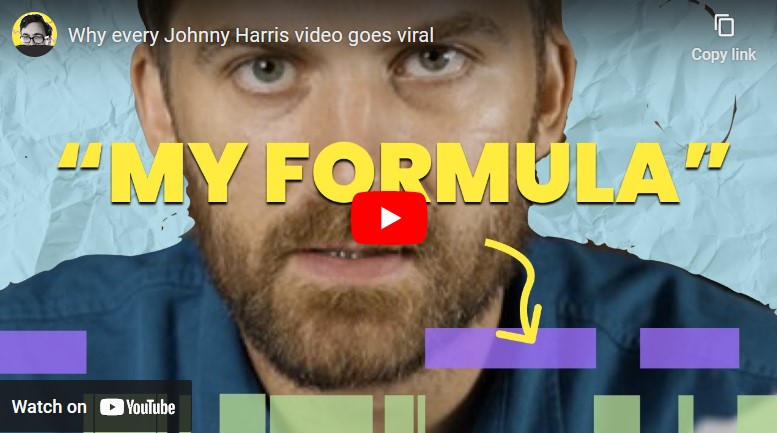
I have a knee-jerk reaction when people try to sell you a “formula.” (Think about all those horrific youtube ads).
But there is something to learn from Emmy-nominated Johnny Harris and his crew who have been producing superb investigative documentaries on youtube. If you watch a handful of his videos, there is nothing formulaic about them. Instead, what you might notice about the way he structures his film ends up feeling like this is his “style” of production.
My takeaway from this explanation video and how this applies to the practice of psychotherapy:
– Structure provides guidance:
You are a guide to the process, so provide the scaffolds of a. where you are, b. where you are going, and c. why you are guiding the person to go in this direction.
– Experience before explanation:
The videographer here says, “understanding something begins with experiencing it on some level.”
“Good explanation does not rest in our heads, but in a body of vivid experiences.”
– See related:
Explainoholic
Information is Not Transformation
Structure builds to impact. - ⭕️ Archives From My Desk: “I Don’t Mean to be Mean, But…”
In this article, I’d walk you through not just a way to engage in deliberate practice, but how to learn from others in structuring your work.
We take a deep analysis of a couples therapy session conducted by Esther Perel, and deconstruct the segments using a grid that I’ve devised called the Impact of Session Grid (ISG).
The Impact of Session Grid of the couples therapy session.
- ⏸ Words Worth Contemplating:
“Great creative minds think like artists but work like accountants.”
~ journalist and author, David Brooks.
Reflection:
What is your relationship with structure and flexibility in the way you conduct your sessions?
PART III
- Research: Antagonism Between Achievement and Enjoyment in LearningI learned about this piece of research from Scott H. Young, author of Ultralearning. He listed this study in his blog as one of his top 10 favorite paper on the science of learning and thinking.
Key Grafs:
– Students often report enjoying the method from which they learn the least.
– Low ability students typically report liking more permissive instructional methods, apparently because they allow them to maintain a “low profile” so that their failures are not as visible. They will report enjoying methods which appear to them to bring maximum achievement with less investment of time and work
– However, in order to experience maximum achievement low ability students require less permissive methods which lower the information processing load on them.
– High ability students like more structured methods which they believe will make their efforts more efficient. High ability students seem to learn more from more permissive approaches which allow them to bring their own considerable skills to bear on learning tasks.
Implications from learning sciences to psychotherapy:
– Generally speaking, it seems to me that the highly conscientious, motivated and higher-functioning clients want more “structure” in treatment.
– In turn, the less conscientious, less motivated and lower-functioning clients might not be the first ones to put up their hands for “more structure and focus” in treatment. This might be a function of overwhelm and being psychologically drained by the challenges that led them to therapy in the first place.
– The real challenge for therapists is to not only meet where the clients are at, but also to scaffold and provide “a difference that makes a difference.”
– In other words, a higher-functioning clients might benefit from more open-ended guidance (i.e., “Go wide”), while clients who are in more distress might benefit from a more focused and scaffolded approach (i.e., “Go narrow”).
– Note: I might have run the risk of over-extrapolating from this single aptitude-treatment interaction (ATI) study.
– The key takeaway is that we are susceptible to be poor judges on how we learn best. - My Weekly Therapy Learnings Notes:
I’ve talked about the practice of capturing your own weekly therapy learnings as a practice of weaving your encounters into potential deep learnings.
Here’s two of mine that are related to structure (and blunders):
i. No. 376. “Where Are You?”
Date: 8 Aug 22I found myself asking clients this as an entrance to the session last week, “Where are you?””Where are you” denotes1. A placement of self, and2. where the person wants to goIt’s also not just about what’s happening on the outside, but what’s happening on the inside.
This is linked to the idea of Fuubutsushi
ii. No. 369. Provide the Intent
Date: 27 Apr 22.Today, I had the Session Rating Scale (SRS) rated lower by a client at 8.5/10 for methods/approach. I wasn’t expecting this. Given that he was highly motivated and doing well, he said he would have appreciated more structure in the session today.Turns out, what he meant was that he wanted clarity of what we were doing, and why.Last week, I had a similar feedback from a different client. He rated lower in methods too. He thought I was trying to address a “deficit” in his interpersonal ability, but that wasn’t where I was coming from. I was only trying to understand the relational context, and then go deeper into the intra-personal conflicts that he was facing in his inner-life.
…Then I realised the mistake I’ve made on both occasions: I’ve not made my intentions clear. Argh…
Note to self:
– Explicate my intentions, where we are going and why. - Research: The Importance of Problem-Focused Treatments: A Meta-Analysis of Anxiety Treatments
This study is mentioned in our upcoming book, The Field Guide to Better Results. Noah Yulish and Nick Oleen-Junk cited a meta-analysis that Yulish and colleagues conducted in 2017.
Based on 135 studies with more than 175 comparisons, they found that regardless of theoretical orientation, addressing clients’ problems with focused interventions is a key structural ingredient of all effective treatment.
This overlaps my clinical experience, especially when working with people who come in with specific concerns like anxiety-related symptoms. At times, even at the start of therapy, a person with specific problems may report high functioning on global wellbeing scales. In part, this may be due to the specificity of the issue and that it’s not bleeding into their relational and occupational life, and/or may be due to behavioral and emotional avoidance in order to cope, which in turn makes their global functioning scores higher that when they are confronting their fears. In such instances, a focused and structured guidance of the process is likely to be more helpful than a free-flowing, unstructured therapeutic framework. - ⭕️ Archives From My Desk: Why Structure and Deconstructing Impact
For those who might have missed this two essays.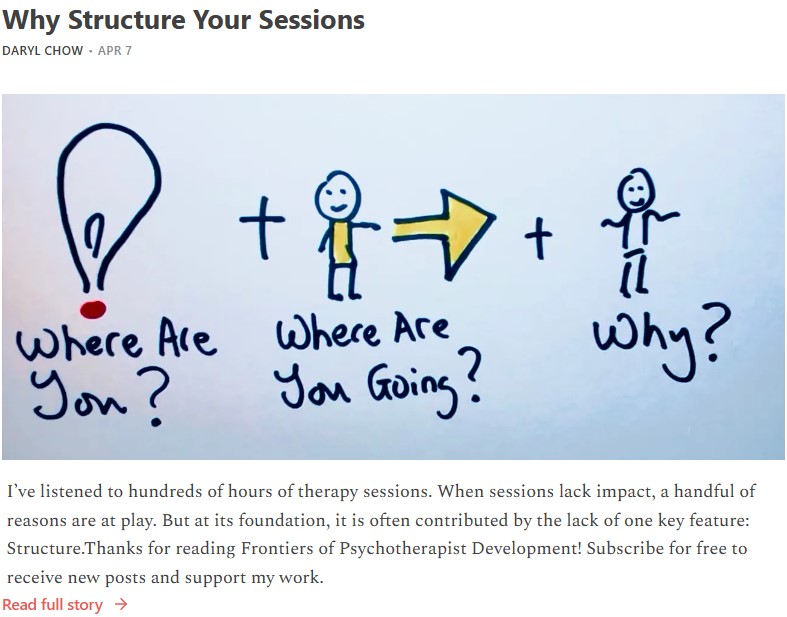

- ⏸ Words Worth Contemplating:
“Structure in psychotherapy is the safety net that allows for exploration and growth.”
~ Irvin Yalom, Love’s Executioner.
Reflection:
Take a moment to map this out.
How do you structure your sessions?
What do you notice after doing this exercise?



Recent Comments